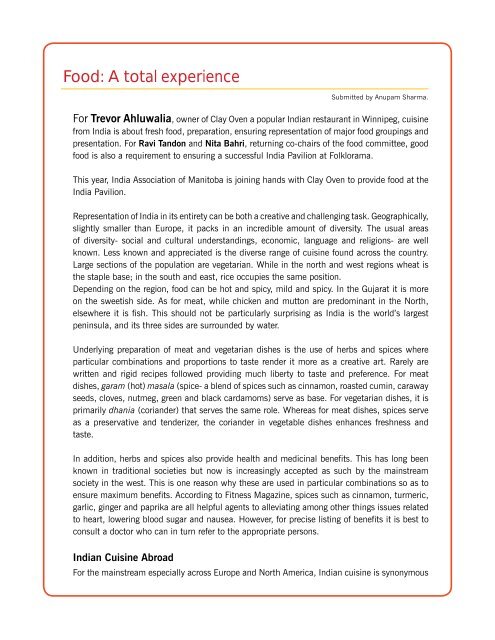IAM - Folklorama Magazine 2008 - Indian Association of Manitoba
IAM - Folklorama Magazine 2008 - Indian Association of Manitoba
IAM - Folklorama Magazine 2008 - Indian Association of Manitoba
You also want an ePaper? Increase the reach of your titles
YUMPU automatically turns print PDFs into web optimized ePapers that Google loves.
Food: A total experience<br />
Submitted by Anupam Sharma.<br />
For Trevor Ahluwalia, owner <strong>of</strong> Clay Oven a popular <strong>Indian</strong> restaurant in Winnipeg, cuisine<br />
from India is about fresh food, preparation, ensuring representation <strong>of</strong> major food groupings and<br />
presentation. For Ravi Tandon and Nita Bahri, returning co-chairs <strong>of</strong> the food committee, good<br />
food is also a requirement to ensuring a successful India Pavilion at <strong>Folklorama</strong>.<br />
This year, India <strong>Association</strong> <strong>of</strong> <strong>Manitoba</strong> is joining hands with Clay Oven to provide food at the<br />
India Pavilion.<br />
Representation <strong>of</strong> India in its entirety can be both a creative and challenging task. Geographically,<br />
slightly smaller than Europe, it packs in an incredible amount <strong>of</strong> diversity. The usual areas<br />
<strong>of</strong> diversity- social and cultural understandings, economic, language and religions- are well<br />
known. Less known and appreciated is the diverse range <strong>of</strong> cuisine found across the country.<br />
Large sections <strong>of</strong> the population are vegetarian. While in the north and west regions wheat is<br />
the staple base; in the south and east, rice occupies the same position.<br />
Depending on the region, food can be hot and spicy, mild and spicy. In the Gujarat it is more<br />
on the sweetish side. As for meat, while chicken and mutton are predominant in the North,<br />
elsewhere it is fish. This should not be particularly surprising as India is the world’s largest<br />
peninsula, and its three sides are surrounded by water.<br />
Underlying preparation <strong>of</strong> meat and vegetarian dishes is the use <strong>of</strong> herbs and spices where<br />
particular combinations and proportions to taste render it more as a creative art. Rarely are<br />
written and rigid recipes followed providing much liberty to taste and preference. For meat<br />
dishes, garam (hot) masala (spice- a blend <strong>of</strong> spices such as cinnamon, roasted cumin, caraway<br />
seeds, cloves, nutmeg, green and black cardamoms) serve as base. For vegetarian dishes, it is<br />
primarily dhania (coriander) that serves the same role. Whereas for meat dishes, spices serve<br />
as a preservative and tenderizer, the coriander in vegetable dishes enhances freshness and<br />
taste.<br />
In addition, herbs and spices also provide health and medicinal benefits. This has long been<br />
known in traditional societies but now is increasingly accepted as such by the mainstream<br />
society in the west. This is one reason why these are used in particular combinations so as to<br />
ensure maximum benefits. According to Fitness <strong>Magazine</strong>, spices such as cinnamon, turmeric,<br />
garlic, ginger and paprika are all helpful agents to alleviating among other things issues related<br />
to heart, lowering blood sugar and nausea. However, for precise listing <strong>of</strong> benefits it is best to<br />
consult a doctor who can in turn refer to the appropriate persons.<br />
<strong>Indian</strong> Cuisine Abroad<br />
For the mainstream especially across Europe and North America, <strong>Indian</strong> cuisine is synonymous


